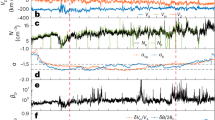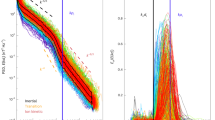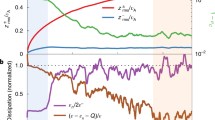Abstract
Magnetohydrodynamic turbulence is a ubiquitous and fundamental ingredient underlying many astrophysical phenomena. The multiphase nature of the interstellar medium and the diversity of driving mechanisms give rise to spatial variation of turbulence properties, particularly plasma properties. There has been no observational diagnosis of the plasma modes beyond the solar system so far. Here we report the identification of different plasma modes in various Galactic environments, including active star-forming zones and supernova remnants, on the basis of our synchrotron polarization analysis. The observed high degree of consistency between the γ-ray excess in the Cygnus cocoon and the location of magnetosonic modes provides strong observational evidence for the long-advocated theory that magnetosonic modes dominate the cosmic ray (CR) scattering and acceleration. Our results open up a new avenue for the study of interstellar turbulence and demonstrate the indispensability of accounting for their plasma properties in all the relevant processes, including CR transport and star formation.
This is a preview of subscription content, access via your institution
Access options
Access Nature and 54 other Nature Portfolio journals
Get Nature+, our best-value online-access subscription
$29.99 / 30 days
cancel any time
Subscribe to this journal
Receive 12 digital issues and online access to articles
$119.00 per year
only $9.92 per issue
Buy this article
- Purchase on Springer Link
- Instant access to full article PDF
Prices may be subject to local taxes which are calculated during checkout





Similar content being viewed by others
Data availability
We used the synchrotron polarization data from the Urumqi 6-cm polarization survey (https://www3.mpifr-bonn.mpg.de/survey.html). The data represented in Figs. 4 and 5 are provided with the paper as source data.
Code availability
We opt not to make the SPA code publicly available now because it is still under development and maintenance. We intend to publish the code at a later time. The codes used to generate the plots presented in this paper are available from the corresponding author upon reasonable request.
Change history
12 February 2021
A Correction to this paper has been published: https://doi.org/10.1038/s41550-020-1152-x
References
Armstrong, J. W., Rickett, B. J. & Spangler, S. R. Electron density power spectrum in the local interstellar medium. Astrophys. J. 443, 209 (1995).
Elmegreen, B. G. & Scalo, J. Interstellar turbulence I: observations and processes. Annu. Rev. Astron. Astrophys. 42, 211–273 (2004).
Goldreich, P. & Sridhar, S. Toward a theory of interstellar turbulence. II. Strong Alfvénic turbulence. Astrophys. J. 438, 763–775 (1995).
Lithwick, Y. & Goldreich, P. Compressible magnetohydrodynamic turbulence in interstellar plasmas. Astrophys. J. 562, 279–296 (2001).
Cho, J. & Lazarian, A. Compressible magnetohydrodynamic turbulence: mode coupling, scaling relations, anisotropy, viscosity-damped regime and astrophysical implications. Mon. Not. R. Astron. Soc. 345, 325–339 (2003).
Makwana, K. D. & Yan, H. Properties of magnetohydrodynamic modes in compressively driven plasma turbulence. Preprint at http://arXiv.org/abs/1907.01853 (2019).
Yan, H. & Lazarian, A. Scattering of cosmic rays by magnetohydrodynamic interstellar turbulence. Phys. Rev. Lett. 89, 281102 (2002).
Lynn, J. W., Quataert, E., Chandran, B. D. G. & Parrish, I. J. Acceleration of relativistic electrons by magnetohydrodynamic turbulence: implications for non-thermal emission from black hole accretion disks. Astrophys. J. 791, 71 (2014).
McKee, C. F. & Ostriker, J. P. A theory of the interstellar medium—three components regulated by supernova explosions in an inhomogeneous substrate. Astrophys. J. 218, 148–169 (1977).
Klessen, R. S. & Hennebelle, P. Accretion-driven turbulence as universal process: galaxies, molecular clouds, and protostellar disks. Astron. Astrophys. 520, A17 (2010).
Sellwood, J. A. & Balbus, S. A. Differential rotation and turbulence in extended H I disks. Astrophys. J. 511, 660–665 (1999).
Kritsuk, A. G. & Norman, M. L. Thermal instability-induced interstellar turbulence. Astrophys. J. Lett. 569, L127–L131 (2002).
Nakamura, F. & Li, Z.-Y. Protostellar turbulence driven by collimated outflows. Astrophys. J. 662, 395–412 (2007).
Yan, H. & Lazarian, A. Cosmic-ray propagation: nonlinear diffusion parallel and perpendicular to mean magnetic field. Astrophys. J. 673, 942–953 (2008).
SHI, M. J. et al. Observations of Alfvén and slow waves in the solar wind near 1 AU. Astrophys. J. 815, 122 (2015).
Yan, H. & Lazarian, A. Cosmic-ray scattering and streaming in compressible magnetohydrodynamic turbulence. Astrophys. J. 614, 757–769 (2004).
Lazarian, A. & Pogosyan, D. Statistical description of synchrotron intensity fluctuations: studies of astrophysical magnetic turbulence. Astrophys. J. 747, 5 (2012).
Brandenburg, A. & Dobler, W. Pencil: finite-difference code for compressible hydrodynamic flows. Astrophysics Source Code Library ascl:1010.060 (2010).
Mignone, A. et al. PLUTO: a numerical code for computational astrophysics. Astrophys. J. Suppl. Ser. 170, 228–242 (2007).
Xiao, L. et al. A Sino-German λ6 cm polarization survey of the Galactic plane. IV. The region from 60° to 129° longitude. Astron. Astrophys. 529, A15 (2011).
Oppermann, N. et al. Estimating extragalactic Faraday rotation. Astron. Astrophys. 575, A118 (2015).
Beerer, I. M. et al. A Spitzer view of star formation in the Cygnus X North complex. Astrophys. J. 720, 679–693 (2010).
Schneider, N. et al. Globules and pillars in Cygnus X. I. Herschel far-infrared imaging of the Cygnus OB2 environment. Astron. Astrophys. 591, A40 (2016).
Wright, N. J. et al. Photoevaporating proplyd-like objects in Cygnus OB2. Astrophys. J. Lett. 746, L21 (2012).
Schneider, N. et al. The link between molecular cloud structure and turbulence. Astron. Astrophys. 529, A1 (2011).
Rygl, K. L. J. et al. Parallaxes and proper motions of interstellar masers toward the Cygnus X star-forming complex. I. Membership of the Cygnus X region. Astron. Astrophys. 539, A79 (2012).
Maia, F. F. S., Moraux, E. & Joncour, I. Young and embedded clusters in Cygnus-X: evidence for building up the initial mass function? Mon. Not. R. Astron. Soc. 458, 3027–3046 (2016).
Ackermann, M. et al. A cocoon of freshly accelerated cosmic rays detected by Fermi in the Cygnus superbubble. Science 334, 1103 (2011).
Abeysekara, A. U. et al. The 2HWC HAWC observatory gamma-ray catalog. Astrophys. J. 843, 40 (2017).
Odegard, N. Decameter wavelength observations of the Rosette Nebula and the Monoceros Loop supernova remnant. Astrophys. J. 301, 813 (1986).
Rozanov, Y. A. Stationary Random Processes (Nauka, Moscow, 1990).
Chepurnov, A. V. The galactic foreground angular spectra. Astron. Astrophys. Trans. 17, 281–300 (1998).
Dame, T. M., Hartmann, D. & Thaddeus, P. The Milky Way in molecular clouds: a new complete CO survey. Astrophys. J. 547, 792–813 (2001).
Acknowledgements
We thank the following colleagues for helpful communications on various topics discussed in this paper: F. Boulanger, M. Gangi, S. Gao, A. Lazarian, H. B. Liu, R. Liu, J. Liu, M. Pohl, I. Sushch, A. Taylor, J. Volmer, M. Vorster, X. Wu and Q. Zhu. S.A. acknowledges support from the DESY summer student programme.
Author information
Authors and Affiliations
Contributions
H.Y. oversaw the project. A.C., H.Y. and H.Z. contributed to the theoretical analysis of SPA. K.M. and R.S.-L. prepared the turbulence data. H.Z. carried out the numerical simulation, performed the probability distribution analysis on the simulation results and led the establishment of the SPA recipe. A.C., S.A. and H.Z. analysed the data from real observations. H.Z. and H.Y. interpreted the observational results and led the manuscript preparation. H.Y. and A.C. designed the project. All authors discussed the project and commented on the manuscript.
Corresponding author
Ethics declarations
Competing interests
The authors declare no competing interests.
Additional information
Publisher’s note Springer Nature remains neutral with regard to jurisdictional claims in published maps and institutional affiliations.
Extended data
Extended Data Fig. 1 Theoretical analysis and decomposed modes test.
(a–c) Theoretical Analyses. The different colours represent different Alfvénic-Mach numbers MA. For MS modes, the solid lines are for the high-β cases and the dashed lines refer to the low-β cases. The dashed-dotted lines marks rxx=-2/3 (d–f) Numerical tests. The color code for signatures: Green- “Alfvénic”; Red- “MS”; Purple- “Ambiguous”. For slow modes with high-β and MA~1, all the observed results are rejected according to the classification threshold (Fig. 3 in the main text).
Extended Data Fig. 2 MS and Alfvénic signature percentages in clustering.
The spot and cluster core scales are marked on the map. Each grid shown here corresponds the information of the cluster core whose center is the grid, as depicted on the top left part of each figure. The color on each grid reveals the percentage of (a)(c) MS and (b)(d) Alfvénic signature at the corresponding cluster. The background is the synchrotron intensity map.
Supplementary information
Supplementary Information
Supplementary discussion.
Source data
Source Data Fig. 4
Statistical source data.
Source Data Fig. 5
Statistical source data.
Rights and permissions
About this article
Cite this article
Zhang, H., Chepurnov, A., Yan, H. et al. Identification of plasma modes in Galactic turbulence with synchrotron polarization. Nat Astron 4, 1001–1008 (2020). https://doi.org/10.1038/s41550-020-1093-4
Received:
Accepted:
Published:
Issue Date:
DOI: https://doi.org/10.1038/s41550-020-1093-4



